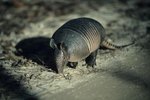Termites are a danger to homes, and homeowners usually treat termite infestations with insecticides. Termites are an ancient order of insects that originated in the Permian period. Most closely related to cockroaches, they are notoriously difficult to eradicate. Termites also fall prey to a variety of vertebrates, microorganisms and insects.
Ants

Ants are a common natural predator of termites. Ants often attack and take over entire termite colonies. Fire ants, legionary ants, and wood ants all prey on chimney building and wood dwelling termites. Carpenter ants inhabit conquered colonies of termites and are often mistakenly blamed for damage to homes.
Beetles

Black ground beetles, the violet ground beetle and woodland beetles all prey on foraging termites. Useful as biological control agents to prevent crop damage, beetles provide co-benefits by preying upon other insect pests and improving soil aeration. One species of beetle parasitizes termite colonies via mimicry.
Humpback Flies

While potential pests themselves, humpback flies, also prey on termites. Resembling fruit flies except for a distinct hump on their abdomen, the parasitic members of the family lay their eggs in termite bodies and other large insects. Used as a biological control agent for many notable pests, they have yet to attain wide application for termite control.
Dragonflies

Dragonflies can be found preying on termites from mid flight in their airborne, or alate, reproductive stage. Dragonfly larvae live in fast flowing streams of high quality water, breathing via posterior tracheal gills. Dragonfly predation can inhibit the spread and establishment of new colonies.
Praying Mantis

Praying mantises are actually closely related to termites. A generalist predator, mantises ambush their prey by disguising themselves as part of the surrounding vegetation. Praying mantises can be significant predators of foraging termites when exposed, but not within termite colonies.
Arachnids

More commonly known as spiders, arachnids have been shown to prey on termites wherever they are found. Some also dwell within the mound material. Others specialize in weaving webs near foraging routes, even baiting webs with decomposing wood.
Assassin bug

These sharp beaked insects commonly known as assassin bugs, have some members that prey solely on termites. The nymphs of these aptly named critters cover themselves with nest material to hide in both internal and external walls of termite colonies. Assassin bugs even use the hollowed out carcasses of former prey to attract new prey.
References
Photo Credits
-
termites image by Christophe Fouquin from Fotolia.com
Writer Bio
Paul Parsons is a freelance writer, living in Houston, Texas. Parsons writes from an array of different topics, but specializes in medical, personal finance, computers and business.



